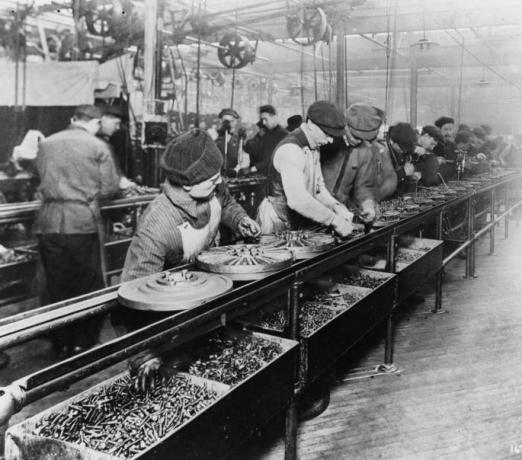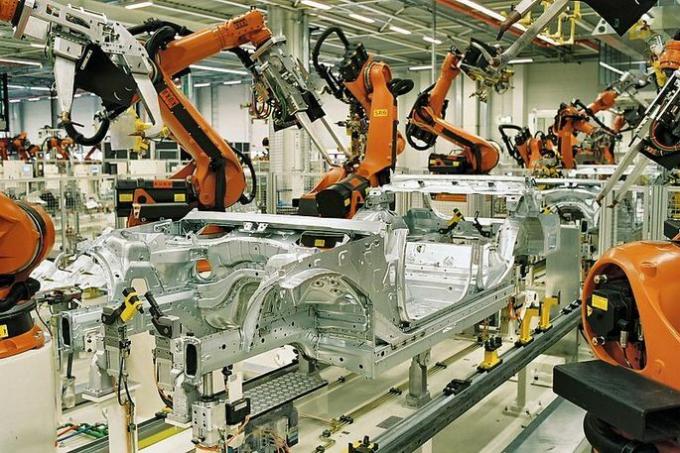The Industrial Revolution is a process divided into three phases, each phase refers to a change in the mode of production and its consequences in the transformation of society.
The First Industrial Revolution, which took place in the second half of the 18th century, is marked by the emergence of the steam engine and the transition from manufacturing to large-scale production (machine-making).
The Second Industrial Revolution, which took place in the second half of the 19th century and in the first half of the 20th century, was marked by the use of electricity and the organization of workers.
And, the Third Industrial Revolution, which occurs since the end of World War II, having as main characteristics, technological advances and the optimization of the industrial process.
| First Industrial Revolution | Second Industrial Revolution | Third Industrial Revolution | |
|---|---|---|---|
| Characteristics |
Disruption with the manufacturing mode of production. urbanization process Industrialization |
industrialism monopoly capitalism Production rationalization and control |
Hyperproduction Hyperconsumption globalization Big business monopoly |
| Technology employed |
power loom spinning machine Steam machine Coal |
Electrical light Incandescent lamp electric motor assembly mat steel making Means of communication (telegraph, telephone) |
electronics robotics Information and Communication Technology (ICT) |
| Local | England | Countries in Europe, United States and Japan |
across the globe multinational companies |
| Period | 1750-1850 | 1850-1950 | 1950-present |
First Industrial Revolution (1750 – 1850)
The first industrial revolution took place in England in the second half of the 18th century. Several factors contributed to its development.
The tightening of laws on land ownership in the countryside forced the displacement of people to the urban centers of the country. This formed an abundance of idle labor, which, together with a prosperous economy and a very developed manufacturing sector, allowed for large investments in production.
The increase in the demands of the domestic and foreign markets required an acceleration of production. New production techniques were implemented with the help of the first mechanical machines. The increased production generated profit and allowed more investments in new technologies.
The invention of the mechanical loom and the spinning machine boosted textile production and the invention of the steam engine revolutionized the way of production.

An ever-increasing number of workers was required in factories until, in the early 19th century, the development of machinery began to replace the need for manpower. Machines replaced part of the workers, giving rise to organized revolts such as Ludism.
Luddism was a movement of workers who, following the example of Ned Ludd, began to destroy machines and stop production.
Another workers' movement that emerged at the time was chartism, the organization claimed in its Letter to the People, better working conditions and participation in politics.
The transformation of old manufacturing into large-scale production of machine-making lasted until the mid-nineteenth century, when new advances inaugurated another phase of the industrial revolution.
Second Industrial Revolution (1850 – 1950)
The Second Industrial Revolution occurs as a result of the example set by England. Other European countries such as France, Belgium, Italy and Germany started to invest in the industrial sector.
Outside Europe, the main countries to industrialize were the United States and Japan.
Investments in factory production made it possible to implement electricity in production. The invention of the light bulb and later the electric motor took production to a new stage.
Series production is born, and the optimization of production from its segmentation and creation of the assembly line. This proposal was developed by Henry Ford and became known as Fordism.

In Fordism, workers no longer participate in the entire production process, the invention of the assembly mat makes employees to be tasked with short, simple tasks and become experts at them, accelerating the production.
With this change, it is the product that travels throughout the factory on the assembly conveyor, while the worker performs the task in his determined position.
Series production lowers costs per product and increases industrial profits.
Still as a way to optimize production, the engineer Frederick Taylor, proposed the rationalization of the process productive from supervision and control, using the maximum potential of workers and machines.
This process of production control and called Taylorism and allied to Fordism are the main marks of the second phase of the Industrial Revolution.
Third Industrial Revolution (1950 – present)
The Third Industrial Revolution is the digital, electronics, robotics and Information and Communication Technologies (ICT) revolution.
Technological advances after World War II enabled production far beyond the demand for products. With this, the need to find means for the assimilation of production was generated. The two main outputs were:
- Hyperconsumption - stimulus to consumption above needs
- The search for new consumer markets
For the success of this phase of the Industrial Revolution, the development of means of transport was crucial. With hyperproduction, it became necessary to develop production flow.

Maritime and air transport allowed the conquest of new consumer markets, which were previously too far away, with costs that made trade unfeasible.
On the other hand, the reduction in the costs of implementing technologies allowed the installation of industries in new countries, as is the case in Brazil. In these countries, what was called late industrialization took place.
In this context, there was the development of companies with headquarters in different countries, called multinational companies.
It is worth remembering that during most of the second half of the 20th century, the world was polarized between capitalist bloc, led by the United States and the socialist bloc, led by the Soviet Union. Each block developed its industries and organized its production.
With the fall of the Berlin Wall and the end of the Soviet Union, the last obstacle to production falls and the 1990s are marked by the beginning of the globalization process.
This made it possible to segment production in several countries, the control and production areas of the industry no longer needed to be in the same place. A process of outsourcing production segments began in search of more attractive locations that could further reduce costs, maximizing profits.
Transnational companies appear, segmented across the globe and which mark this phase of the Industrial Revolution.
See too:
- Fordism, Taylorism and Toyotism
- Microeconomics and macroeconomics
- Import and Export



